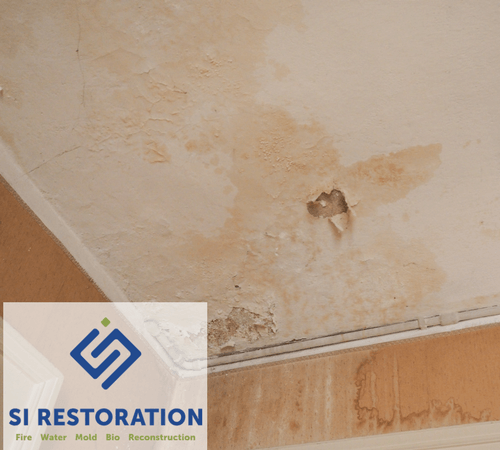If you have a water stain on your ceiling your first instinct might to be to simply paint over it, however it will probably just come back as the cause of it hasn’t been addressed. You might be only seeing a small stain and think you can delay repairs, however a water stain is the one of the last signs of a leak. The leak could be at the point of bursting and you won’t know how long you have until you find the source of the moisture.

Locating the leak
Where the stain is might not be where the leak is. Water could be running down the pipes and then dripping on the ceiling away from the leak. Finding the leak could be expensive as you might have to cut a few holes to inspect areas and buy tools for a more thorough inspection.
Identify the most logical water source.
What is the area closest to the leak? Is the roof above, is there a bathroom above? Maybe you have a bedroom above but have an old air conditioner that is slowly leaking. Appliances such as dish washers and refrigerators that have a direct water line are a common source of leaks.
Determine timeline of leak
Did you notice the stain about an hour after a shower? Was there a big rain storm the night before? Did an appliance fail? Making a note of what happen will help determine where the source of the water is from. If the stain appeared after a big storm, you may have an issue with your roof or gutters. Your shower pan or tub may have had a caulk seal fail.
Check water quality from stain
What color is the water? If the water dripping is clear and doesn’t smell, it’s probably from a fresh water source such as a pipe. If the water is dirty it may be from the roof or coming from a drain.
The water direction and flow
Can you see where the water is coming from? Try to track the flow of the leak. Determine if it is dripping from above or there is a trail that leads to a different potential source. Wiping away the water and checking how soon the water comes back can also help determine a slow leak or something that is still leaking and needs some urgent repair.
Common Causes
- Gutters full or clogged causing water to pool on roof
- Roof damage
- Caulk seal failure
- Hard water causing damage to older pipes
- Old pipes eroded
- Frozen pipes
- Pipe sweating
- Appliance water line
- Burst pipe due to blocked flow
When to call a professional
If you are hesitant to make a small hole in the ceiling or make repairs, the work is probably out of your scope. You could cause more damage trying to find the source or make repairs and it would be more cost effective to call in a professional.
If you think you are going to need multiple expensive tools for a one-time repair than it would also be more cost effective to hire a professional. Some of the tools you would need to locate the source would be a borescope and a moisture meter. These are specialized tools that would rarely be used by most homeowners and it could be cheaper just to hire a professional for an inspection.
Precautions
- Check your insurance policy for coverage. If you are covered for leaks and you attempt repairs yourself you could void the policy.
- Have a few plumber’s phone numbers ready in case of a burst pipe emergency.
- Locate the main water source to your house so you know where to shut off the water and minimize flooding.
- Have a water restoration company phone number ready in case of a flood. Removing the water quickly should be a priority. Water can get absorbed by furniture, paper, and your wooden floors and become permanently damage quickly. Restoration companies have specialized tools to remove the water, dry the area, and repair any water damage.
SI Restoration water damage clean up services are available in the following Maryland areas :
Towson
Pikesville
Catonsville
Bel Air
Baltimore City
Baltimore County
Dundalk
Essex
Laurel
Parkton
Westminister